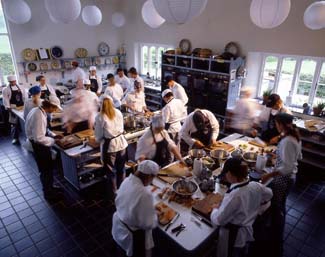The Darina Allen Column - Early Summer Recipes

This month Darina shares the joys of early summer food
We are coming into the most super exciting time of the year for both cooks and gardeners. The summer produce is ready to harvest at last... We are now picking the early broad beans and peas to add to the beets, courgettes and carrots we’ve been enjoying for the past few weeks.
Everybody, young and old, looks forward to the first new home grown potatoes. We’ve been digging our crop of organic casa blanca and colleens for over a month now. They were planted in the greenhouses way back in January and have produced an abundant crop of irresistible new potatoes to soak up lots of butter and flaky sea salt. They are almost gone now so there will be a gap of several weeks before the outside “earlies” come on stream.
There are also lots of salad leaves and lettuces heading up nicely in the No Dig beds, little scallions and fine new season’s onions with juicy green tops that we stew down in butter to melting tenderness with thyme leaves. Suddenly it’s a feast - the Hungry Gap is over...
Only those who love to garden will really understand the magic, the joy and satisfaction that comes with sowing a few seeds, then watching them grow from tiny seedlings into plants and eventually maturing into beautiful beets, courgettes, carrots…
At least three months of care and anticipation, then the moment arrives to harvest, cook, eat and relish, WOW, do you enjoy every single morsel… you want everyone to know you grew it and eat it slowly and be nourished and enchanted by the startlingly delicious flavour of your freshly picked vegetables and herbs and indeed fruit. If you haven’t had the chance or indeed inclination to grow your own, then head for your local Farmers Market this weekend, where you are bound to find lots of new season’s produce.
The strawberries are now ripening - Cambridge Favourite, Alice, Honeycomb, no prizes for size in comparison to the supermarket berries but do they score on taste…WOW, a forgotten flavour for many.
So, how to make the best use of every single scrap of produce. The peas, I can scarcely bear to cook, we just put a bowl of freshly picked peas on the table for everyone to shell their own and feel the magic of eating them straight from the pods. The latter can be made into pea pod soup, but here’s a new pea mousse recipe we’ve been enjoying with fresh radishes - it makes a delicious starter.
Young beets cook quickly in boiling salted water, but roasting concentrates the flavour and even further enhances this humble vegetable. Don’t waste the stalks or leaves, both can be cooked and used in salads also.
I’m also including a cocktail recipe from a darling little book on Poptails, written by Cesar and Nadia Roden who had the inspired idea of combining popsicles and cocktails - how cute and super delicious is that, published by Quadrille.
EARLY SUMMER RECIPES
Pea Mousse with Pea Shoots, Radishes and Shrimps
This is my interpretation of a delicious starter dish that I ate recently at a restaurant in London. It is exquisite made with fresh peas but I have to admit, I have also made it with frozen peas and the result has been pretty delicious. We use the beautiful little shrimps (palaemon serratus) from Ballycotton but it’s also good without them.
Serves 6
Mousse
500g fresh peas
½ teaspoon salt
½ teaspoon sugar
1 gelatine leaf
150ml water
Salt, freshly ground pepper and sugar
100ml of softly whipped cream
1 tablespoon chopped mint
Garnish
50g fresh peas, blanched and refreshed
A mixture of French Breakfast and Cherry Belle radishes
Tender fresh pea shoots
75 – 100g small pink shrimps (palaemon serratus), cooked
Extra virgin olive oil
Flaky sea salt
Bring 150ml fresh cold water to a fast rolling boil, add salt. sugar and peas, return to the boil for 2-3 minutes, drain, save the cooking water, and refresh the peas under cold water.
When cold, whizz to a smooth puree with 100ml cooking water. Push through a nylon sieve into a bowl, chill.
Soak the gelatine in cold water, allow to soften for 4-5 minutes, drain, then dissolve the softened leaf in a tablespoon of hot water. Add the pea puree gradually then cover and chill for 30 minutes to 1 hour or until just beginning to set. Fold in the softly whipped cream. Divide between 6 wide soup bowls, cover and allow to set.
Meanwhile, trim and slice the radishes lengthwise and put into iced water.
To Serve:
Put the peas into a bowl, add the peeled shrimps and the pea shoots. Drizzle lightly with extra virgin olive oil, a few flakes of sea salt and freshly ground pepper. Toss.
Top each mousse with a generous portion, scatter 5 or 6 slices of radish over the top, add a couple of drops of extra virgin olive oil and a few flakes of sea salt and serve
Chicken in Beetroot & Spring Onion, Panzanella with Pine Nuts & Wild Garlic
Here is an adaptation of a recipe Jacob Kennedy did at Litfest, the combination of roast beetroot and chicken is super delicious. He used wild garlic but that’s out of season now so we’ve been enjoying with rocket and watercress leaves.
The recipe below is for a roast chicken, but it could equally be cooked on the barbecue, or be replaced by poussin, squab pigeon, guinea fowl, pheasant or duck – just adjust the cooking times accordingly.
Equally the panzanella can be made with the season’s crop – roast or raw peppers, roast or raw radicchio, tomatoes, girolles, porcini, or here the first new seasons beets.
Serves 3-4 as a main
3 bunches baby beetroots, and their leaves
6 tablespoons extra virgin olive oil
1 chicken, organic or free range
1 bunch spring onions, cut in 2cm (3/4 inch) lengths
4 slab-like slices rustic bread, 2cm (3/4 inch) thick, torn into chunks
1 big handful of fresh rocket leaves or watercress, (150g/5oz), roughly chopped
40g (1 1/2oz) pine nuts (preferably long ones), lightly toasted
1 garlic clove, crushed
3 tablespoons red wine vinegar
2 big handfuls salad leaves, baby or torn
Preheat the oven to 220ºC/425ºF/Gas Mark 7.
Scrub the beetroots thoroughly, to remove the remotest chance of grit (you can peel them, but its messy and wasteful). Wash the leaves well. Blanch the leaves 5 minutes in well-salted water ‘til just tender – drain, refresh, and set aside.
Cut the beetroots into bite-sized chunks (for babies, just halve or quarter them). Toss with salt, pepper and half the oil and put into a large roasting tin. Cook for 45 minutes until, well, starting to cook.
Season the chicken well inside and out and place on top of the beets in the oven, upside-down. When half cooked, turn it over and finish breast side up (a medium chicken will need about half an hour on each side). 20-30 minutes before the bird is cooked, take the pan momentarily from the oven and toss the bread and spring onions into the beetroots and chicken juices, returning the bird onto its panzanella bed before returning to the oven.
When cooked, take the chicken out and set it to rest. Add the watercress or rocket leaves, blanched beetroot leaves and pine nuts to the roasting tin of bread and beets. Stir together the remaining oil with the garlic and vinegar and drizzle this dressing into the pan. Return it to the oven for a final 5 minutes while the chicken rests.
Joint the chicken, and toss it into its warm salad of toasted bread and beetroot, adding the salad leaves at the very last moment. Serve in a big bowl in the centre of the table, to share from.

Cesar and Nadia Roden’s Strawberry Daiquiri
Taken from Poptails by Cesar and Nadia Roden, published by Quadrille
Makes 8-10
450 g (1 lb) strawberries, hulled and quartered
100 g (½ cup) sugar, caster or granulated
2 tablespoons freshly squeezed lime juice
90 ml (6 tablespoons) white rum, plus extra, optional for trickling
125 ml (½ cup) water
For the garnish (optional)
Thin slice of strawberry for each
Put the quartered strawberries into a bowl, sprinkle over the sugar, stir in the lime juice and rum and set aside to macerate for 30 minutes or longer.
Transfer to a food processor, add the water and blend until smooth.
Fill the moulds, leaving a little space at the top. You can push the lolly sticks through a thin slice of strawberry if you like and insert them into the moulds; the strawberry slice will secure the stick. (Alternatively freeze until slushy, 60-90 minutes, then insert the sticks).
Freeze until solid, at least 5 hours or overnight.
---
'30 Years at Ballymaloe' - Bord Gáis Avonmore Cookbook of the Year 2013
Good Food Ireland Cookery School of the Year 2012/2013
***
 Once again, the
Once again, the
Sitting in the middle of a 100 acre organic farm the Ballymaloe Cookery School provides its students not only with a life skill learnt under the expert tutelage of their very capable teachers but also a place to relax and unwind from the stresses and strains of normal everyday life. The cottage accommodation available onsite for residential courses consists of a collection of delightful converted outbuildings which have been transformed over the years by the Allens, and other accommodation is available locally for the short courses.
www.cookingisfun.ie






There are currently no comments
Leave a comment
Not a member? Register for your free membership now!
Or leave a comment by logging in with: